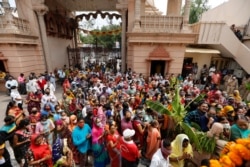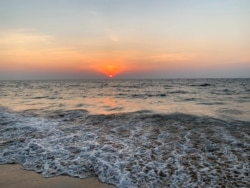It’s vacation time for young and old visitors crowding Shimla, one of North India’s most popular hill stations. Some ride horses, others sit at scenic spots soaking in the sight of Himalayan slopes, others snack at cafes in the charming town.
But health officials warn that the massive holiday crowds visiting hill towns and beach resorts in recent weeks could jeopardize the gains made in the fight against the coronavirus. A second wave ripped through the country in April and May.
India is in the throes of what the health ministry called “revenge travel” — a buzzword coined for the urge to break free and vacation after a year of stress, anxiety and isolation as cities remained shut.
“I came to enjoy. I was confined at home for a long time due to COVID. So, I and my friends wanted an outing,” said Yamini Sharma, who traveled to Shimla with her friends from Chandigarh in northern India.
The crowds of vacationers are causing alarm in a country where health experts said events such as massive political rallies and religious gatherings earlier this year had contributed to the spread of the highly transmissible delta variant. As daily new infections had hit a high of over 400,000 a day in May, the health system buckled, hospital beds ran out, and people made desperate appeals for oxygen and critical medicines.
Most people had shut themselves indoors as fear gripped Indian cities. But that has changed dramatically as authorities eased restrictions and infections declined.
“I will say very emphatically that it is not OK to have huge crowds in hill stations, markets, without wearing masks,” Prime Minister Narendra Modi said on Tuesday addressing a meeting of eight chief ministers. “The virus does not come and go on its own. We bring it when we disobey the rules.”
Pointing to images and videos of holiday crowds that have gone viral on social media, top health officials stressed that India is still struggling with the pandemic.
“The war is not over yet,” Vinod K. Paul, who heads the federal government’s group on COVID management, said at a news conference last week. “If we don’t take precautions, we are giving the virus an opportunity to infect us. It is with great difficulty that cases have declined but this can be reversed because we have not won victory over the virus.”
Concerns are high because just over 5% of the country has been fully inoculated — India’s immunization program has moved slowly due to vaccine shortages.
Health experts and doctors have repeatedly warned that crowds could bring on an early third wave.
India’s top body representing doctors, the Indian Medical Association, has appealed to state governments and citizens not to lower their guard.
“Tourist bonanza, pilgrimage travel, religious fervor are all needed, but can wait for few more months,” the IMA said in a statement. “Enabling people without vaccination to go scot-free in these mass gatherings are potential super spreaders for the COVID third wave.”
Such warnings are getting a mixed response. The northern Uttarakhand state that is already crowded with tourists, suspended a pilgrimage that sees tens of thousands of devotees travel through several states. However, a neighboring state, Uttar Pradesh, which was among the worst affected during the second wave, said it would allow the event to take place.
A pandemic-weary public rushing for a break acknowledges the risk that COVID-19 still poses but for the time being appears to be shrugging aside such concerns.
“My exams were cancelled recently due to COVID and I felt the need to get out. It is very necessary for mental health,” points out Chakshu Sharma, a college student who travelled to Shimla for a break with his brother.
“It could be problematic. But a person cannot stay shut in the house,” according to Yamini Sharma, another tourist.
Meanwhile “revenge travel” is music to the ears of businesses in states that rely heavily on tourism like Himachal Pradesh. Most of them were struggling to get back on their feet after a strict lockdown last year but a second shutdown this year has again set them back.
“10% of the gross domestic product here comes from tourism in our state,” said Siddharth Bakaria, head of Sahyog Foundation, a volunteer group that is helping develop the tourism sector in Himachal Pradesh. “If we have total restrictions, then it is a huge loss to the hotel industry and people’s livelihoods. Many people have lost jobs.”
India is grappling with the lives versus livelihoods dilemma the pandemic poses to many countries — the need to open up a battered economy and restore jobs even as the threat of surging infections looms large.
Vijay Kumar, who sells popular Indian snacks in his restaurant in Shimla, said he had to cut back supplies amid shutdowns.
“My work was down to 20%,” Kumar said. “But things are looking up again. Now, my business is back to about 60 to 70%.”













